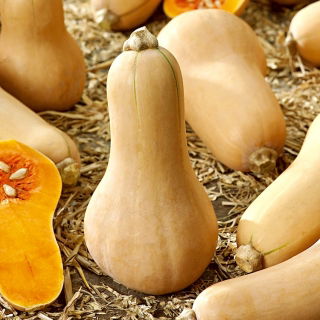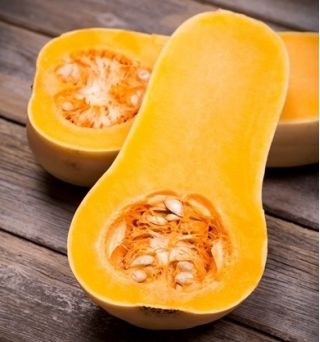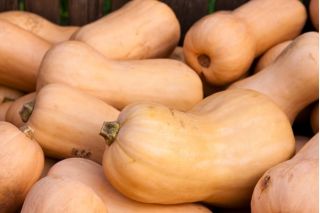Butternut Squash is a highly sought-after variety, prized for its rich flavour, versatility, and nutritional value. This robust plant not only enhances garden aesthetics but also delivers a generous harvest of flavorful fruits perfect for a wide range of culinary uses. With its easy cultivation requirements and high yield potential, Butternut Squash is an excellent addition to any garden, from small plots to larger spaces.
Sowing Butternut Squash
Sow Butternut Squash seeds in fertile, well-prepared soil to ensure optimal growing conditions. The soil should be rich in nutrients and well-drained, facilitating strong root development and healthy plant growth. Whether you are an experienced gardener or a beginner, this variety is easy to cultivate and highly rewarding.
Sowing Depth
For the best germination results, plant Butternut Squash seeds at a depth of 2 to 3 cm. This depth maintains the ideal moisture levels and protects the seeds from drying out, ensuring consistent and rapid germination.
Direct Sowing Period
The perfect time to sow Butternut Squash seeds directly into the ground is in May. By this time, the soil has warmed sufficiently, and the danger of frost has passed. Select a sunny and sheltered location to support vigorous growth and fruit development.
Sowing Period Under Cover
If you prefer an earlier start, sow Butternut Squash seeds under cover in April. This is particularly beneficial in cooler climates, allowing seedlings to establish in a controlled environment before being transplanted outdoors.
Planting Time
Transplant Butternut Squash seedlings into your garden in mid-May when the weather is warm and the soil has reached the right temperature. This timing ensures the plants thrive and reach their full potential during the growing season.
Plant Spacing
Provide ample space for your Butternut Squash plants to grow by maintaining a spacing of 100 x 100 cm. This generous spacing ensures the vines have room to spread, promotes good air circulation, and reduces the risk of diseases.
Site Conditions
Butternut Squash flourishes in sunny locations with well-drained, nutrient-rich soil. Regular watering is essential, especially during dry spells, to keep the plants healthy and productive. Periodic fertilisation with organic materials further supports robust growth and fruiting.
Growing Tips
Successful cultivation of Butternut Squash requires consistent care, including regular watering and weeding. Use natural pest control methods to protect the plants from common pests. Apply organic fertilisers during the growing season to encourage abundant fruit production.
Harvest Period
Harvest your Butternut Squash fruits between September and October when they are fully mature and exhibit their signature rich colour. Ensure you collect the fruits before the first frost to preserve their quality and flavour.
Usage
Butternut Squash is a versatile fruit celebrated for its creamy texture and sweet, nutty flavour. It’s perfect for creating soups, stews, baked dishes, and even desserts. Its high nutritional value makes it a popular choice for health-conscious cooks.
Resistance to Diseases
Butternut Squash is naturally resistant to many common diseases affecting squash plants, making it an easy-to-grow option for gardeners of all experience levels. This resilience minimises the need for chemical treatments and ensures a healthy, bountiful harvest.
Good to Know
Rich in vitamins A and C, as well as dietary fibre, Butternut Squash is a nutritional powerhouse. It stores exceptionally well in cool conditions, retaining its flavour and texture for extended periods, making it a staple for autumn and winter meals.
Why Buy Butternut Squash Seeds from Garden Seeds Market?
Garden Seeds Market offers premium-quality Butternut Squash seeds sourced from certified crops. Our seeds undergo rigorous quality testing to ensure high germination rates and reliability. With fast delivery, competitive prices, and expert gardening advice, we provide everything you need for a successful gardening experience. Join our satisfied customers and grow your garden with confidence.
The packet contains 2 g of seeds, along with detailed cultivation guidelines and a sow-by date for optimal results.














